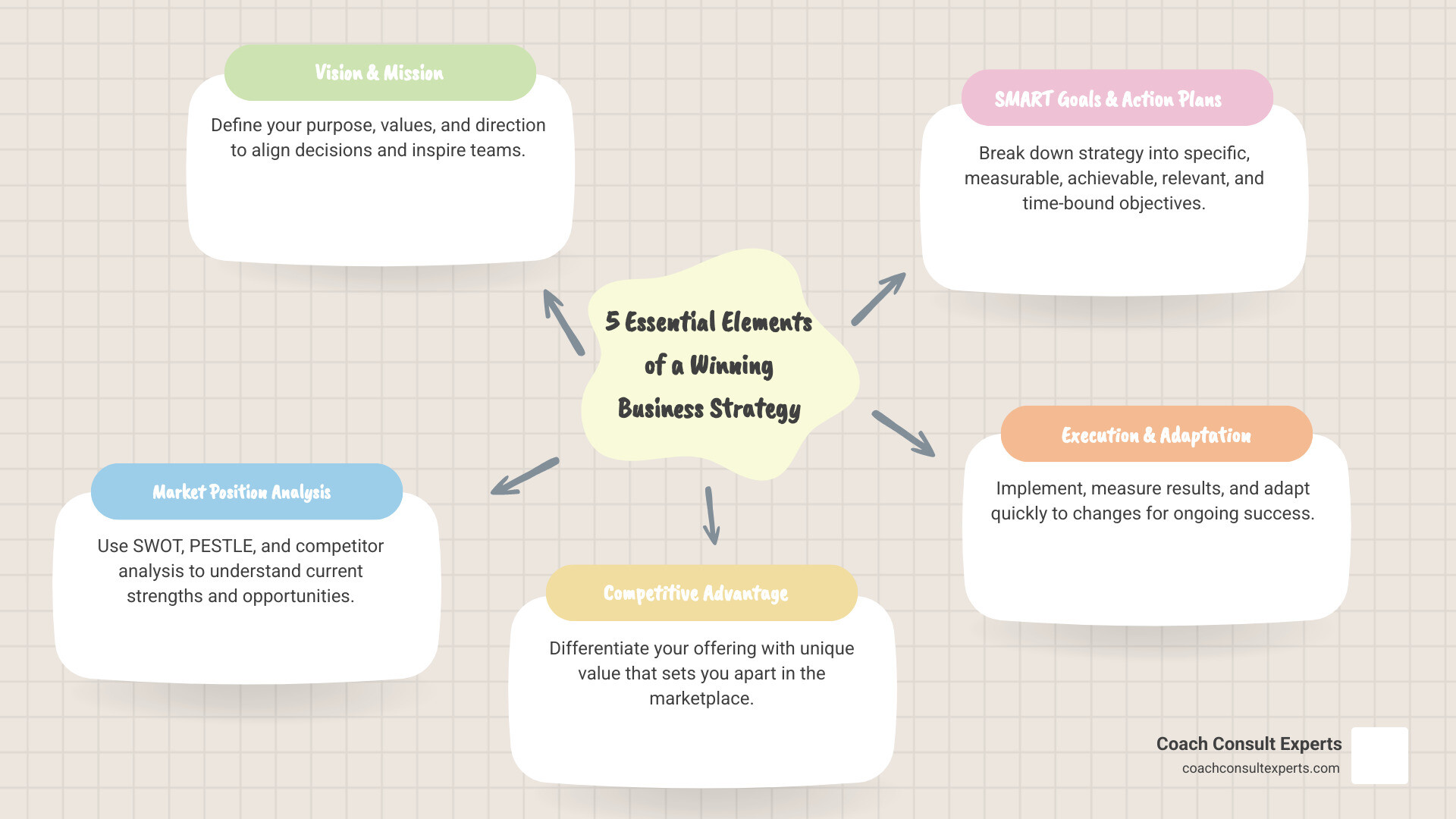Winning Business Strategy: 5 Proven Steps for Massive Success 2025
The Foundation of Business Success
A winning business strategy is a clear roadmap that guides your business decisions, establishes competitive advantage, and drives sustainable growth. It’s the difference between struggling to stay afloat and dominating your market.
The 5 Essential Elements of a Winning Business Strategy:
- Clear vision and mission that defines your purpose
- Market position analysis using proven frameworks
- Competitive advantage that differentiates your offering
- SMART goals with balanced action plans
- Execution system with measurement and adaptation
In today’s uncertain economic climate, playing offense—not just defense—is critical for long-term success. According to a McKinsey survey, companies with a business-building focus grew revenues at three times the rate of their peers following the 2008-09 financial crisis. Yet many organizations struggle to articulate a coherent strategy beyond vague aspirations of “growth” or “excellence.”
The truth is that strategy doesn’t need to be complicated. As Southwest Airlines demonstrated with their “keep planes in the air” philosophy, sometimes the most effective strategies can be expressed in a single phrase that forces clear trade-offs and guides decision-making at every level.
“If you can’t state your strategy in a sentence, you don’t have one!” – This simple but powerful insight reminds us that clarity trumps complexity when it comes to strategy that actually works.
I’m Coach Mary Chege-Kamau, a Professional Certified Coach (PCC) who has helped thousands of professionals develop winning business strategies that align with their core values while driving measurable results across industries from manufacturing to technology. My approach combines practical frameworks with a focus on the human elements that ultimately determine whether a strategy succeeds or fails.

Step 1: Clarify Vision & Mission—Your North Star
Imagine trying to steer a ship without knowing your destination or the purpose of your journey. Pretty challenging, right? That’s exactly why every winning business strategy begins with crystal-clear vision and mission statements—they’re your compass when seas get rough.
Think of your vision statement as that beautiful horizon you’re sailing toward. It should inspire your team while remaining achievable enough that folks don’t dismiss it as fantasy. Your mission statement, meanwhile, is your daily navigation tool—it tells everyone what you’re doing right now, who you’re serving, and what makes your approach special.
I’ve found that creating these statements works best when you bring key people to the table. This isn’t just about getting better ideas (though you will); it’s about building genuine commitment from the people who’ll ultimately bring your strategy to life. When your team helps craft the vision, they naturally become its champions.
Why Vision Matters for a Winning Business Strategy
When market storms hit (and they always do), your vision serves as that unwavering North Star. According to a fascinating IBM study from 2009, a whopping 70% of companies are actively reinventing their business models, with nearly all (98%) making at least some modifications. Without that guiding light, these changes can quickly turn into aimless drifting.
A winning business strategy always puts your customers at the heart of everything. As Peter Drucker so wisely put it, “The sole purpose of a business is to create customers and keep customers by serving them better than anyone else can.” When your vision and mission truly accept this customer-first philosophy, you’re already ahead of most competitors.
At Coach Consult Experts, we’ve seen how developing a leader’s emotional intelligence creates the foundation for an authentic vision that resonates deeply with both customers and team members. There’s something almost magical that happens when leaders operate from this place of clarity—decisions that once seemed complicated suddenly become obvious choices.
The beauty of starting with purpose is that it creates a long-term orientation that weathers short-term challenges. When everyone understands not just what they’re doing but why it matters, your organization develops the resilience needed to stay the course when others might give up.
Your vision and values aren’t just fancy words for your website—they’re the heartbeat of your winning business strategy and the filter through which every important decision should pass.
Step 2: Diagnose Your Current Position with Proven Frameworks
Before mapping your journey forward, you need to know exactly where you stand today. Think of strategic frameworks as your business GPS—they help you pinpoint your current position with clarity and precision.
Let’s explore some powerful tools that can illuminate your path:
SWOT Analysis reveals your internal Strengths and Weaknesses alongside external Opportunities and Threats. It’s like taking a 360-degree snapshot of your business reality.
PESTLE Analysis widens your lens to examine the broader landscape—Political, Economic, Social, Technological, Legal, and Environmental factors that might impact your success.
The Value Stick framework offers a fascinating perspective by analyzing the gap between what customers are willing to pay, what you charge, your costs, and what suppliers are willing to accept. This reveals hidden profit opportunities you might be missing.
Porter’s Five Forces helps you understand competitive intensity—are you swimming in friendly waters or shark-infested seas?
I’ve found the Three Rules particularly powerful with my clients: better before cheaper, revenue before cost, and there are no other rules. This neat simplicity cuts through the noise.
The 80/20 Rule reminds us that roughly 20% of our efforts produce 80% of our results. Identifying that critical 20% can transform your business efficiency.
For niche businesses, the 7-70 Niche Rule offers golden wisdom—target a niche no larger than 10% of your industry and aim to dominate with 70% market share. This focused approach often yields remarkable results.
In our Group Coaching Programs, we help leaders select the frameworks most relevant to their unique situation. The goal isn’t to use every tool in the box but to choose the ones that will yield the most valuable insights for your specific context.
Data should inform your analysis. As one executive wisely noted, “I prefer operating performance measures for true business performance visibility.” Look beyond traditional financial metrics to understand what truly drives customer value and operational excellence.
Tools That Uncover Competitive Advantage
Different frameworks reveal different facets of potential competitive advantage. While SWOT might highlight internal capabilities you can leverage, the Value Stick helps identify opportunities to increase what customers will pay or decrease what suppliers expect.
Blue Ocean Strategy offers a refreshing approach to competitive positioning. Rather than battling in the bloody “red oceans” of fierce competition, it encourages creating uncontested “blue oceans” of new market space. The Blue Ocean Strategy insights emphasize looking beyond existing boundaries to find untapped opportunities.
The magic happens when you connect the dots between different analyses. For example, a strength identified in your SWOT might align perfectly with an opportunity to create a “blue ocean” in an underserved market segment. These connection points often reveal the most powerful strategic insights.
When working with clients, I encourage them to approach these frameworks with curiosity rather than judgment. The goal isn’t to confirm what you already believe but to find what you might be missing. This open mindset is essential for developing a truly winning business strategy that can weather changing market conditions.
Step 3: Craft Competitive Advantage & Differentiation

Now that you understand where you stand, it’s time for the exciting part – defining how you’ll win in your chosen market. This is truly the heart of your winning business strategy – crafting that unique value proposition that makes customers choose you over everyone else.
I’ve seen how the most successful companies follow what Deloitte research calls “The Three Rules.” First, they focus on being better before cheaper – competing on value rather than getting into price wars. Second, they prioritize revenue before cost – growing the top line instead of just cutting expenses. And third? Well, there really aren’t any other rules that matter as much!
Think about Best Buy’s brilliant pivot. When everyone thought physical electronics stores were doomed, they transformed their locations into mini-warehouses that improved both customer convenience and vendor relationships. They didn’t just adapt – they reimagined their existing assets in a way competitors couldn’t easily copy.
Or consider Nike’s approach to competitive advantage. By building a brand that confers status and shapes customer preferences, they’ve created a foundation for premium pricing that’s incredibly powerful. Their $44+ billion in global revenue in 2021 speaks for itself!
When working with my clients to craft their competitive edge, I encourage them to explore four main pathways:
Product/Service Excellence shines when you deliver superior quality or features that customers truly value. Customer Intimacy works wonders when you develop a deeper understanding of customer needs than anyone else. Operational Efficiency can be your secret weapon when you deliver value at lower costs than competitors. And Business Model Innovation – my personal favorite – can completely change the game by reimagining how you create and deliver value.
As one of my entrepreneur clients wisely put it: “Whoever gets closest to their customer wins.” This simple truth reminds us that all competitive advantage ultimately flows from understanding customer needs better than anyone else.
Turning Analysis into a Winning Business Strategy Statement
The magic happens when you distill your competitive advantage into a clear, concise strategy statement. The most effective ones can often be expressed in a single powerful phrase that guides decision-making throughout your organization.
Southwest Airlines nailed it with “Meet customers’ short-haul travel needs at fares competitive with the cost of automobile travel.” Starbucks transformed coffee with “Become the third place between home and work.” And Amazon’s relentless focus on being “the most customer-centric company on Earth” has driven decades of innovation.
These statements work because they force meaningful trade-offs, provide a litmus test for strategic decisions, and set clear boundaries. They answer the fundamental question that every business must address: “How will we win in our chosen market?”
For smaller businesses, I often recommend the 7-70 Rule: identify a niche no larger than 10% of your industry and aim to own 70% of it. This approach has worked wonders for companies like IKEA, which dominates the flat-packed furniture segment with a 72% share and €30 billion in revenue.
In our Business Strategy coaching programs at Coach Consult Experts, we help clients develop these clear strategy statements through a collaborative process that ensures they’re both compelling and actionable. The research backs this approach too – according to Harvard Business School, the most successful strategies balance aspiration with pragmatic execution.
Your winning business strategy isn’t about being all things to all people. It’s about making deliberate choices about where you’ll play and how you’ll win – then aligning everything in your business to deliver on that promise.
Step 4: Set SMART Goals & Balanced Action Plans

Even the most brilliant winning business strategy remains just a hopeful idea without concrete goals and practical action plans. This is where the rubber meets the road—where your vision transforms into tangible outcomes through SMART goals: Specific, Measurable, Achievable, Relevant, and Time-bound objectives.
Think about it: “increase sales” sounds nice but gives your team no real direction. Compare that to “increase sales by 10% in the next quarter by launching two new products and expanding into two new geographic markets.” The difference is night and day! The second goal creates clarity, momentum, and accountability.
When setting these goals, I always remind my clients to keep the value stick framework in mind. Focus first on raising what customers are willing to pay for your offerings—this is where true value creation happens. Then consider ways to improve your supplier relationships to lower their willingness-to-sell price points. These approaches typically yield better results than simply slashing costs.
I’ve seen too many businesses obsess over traditional accounting measures while missing the metrics that actually drive performance. Net realization, gross margins, operating margins, and free cash flow often tell a more complete story about your business health. As one of my clients once said, “I prefer operating performance measures for true business performance visibility.” Smart words!
Resource allocation becomes critical at this stage. Your budget is your strategy in action—where you put your money reveals what you truly value. Be honest: are you investing in initiatives that directly support your strategic priorities, or just maintaining the status quo? Sometimes the hardest part of strategy is deciding what not to do.
For these goals to drive real change, they need to cascade throughout your organization. Each department and individual should understand how their work connects to the bigger picture. In our Braven Mentorship program, we help leaders develop the communication skills to effectively translate high-level strategy into meaningful daily actions for their teams.
Balancing Short-Term Wins with Long-Term Growth
One of the toughest challenges I see businesses face is balancing today’s performance with tomorrow’s potential. According to a revealing 2020 McKinsey survey, 50 percent of revenues five years from now are projected to come from products and services that don’t even exist today. Let that sink in! This highlights why you need both current optimization and future innovation.
Quarterly strategy reviews create the perfect rhythm for this balancing act. These regular check-ins allow your team to celebrate short-term wins (which builds crucial momentum), identify obstacles before they become crises, ensure long-term initiatives stay on track, and reallocate resources based on changing conditions.
I love how Deloitte’s research frames this challenge: successful companies play both “offense” (growth and innovation) and “defense” (efficiency and optimization). It’s not either/or—it’s both. Companies that master this balance consistently outperform their peers in both short and long-term measures.
Your winning business strategy needs both immediate traction and long-term vision. As we often say in our coaching sessions, “Plant trees under whose shade you may never sit.” That’s the mindset that builds truly enduring businesses.
Step 5: Execute, Measure & Adapt Relentlessly

Even the most brilliant strategy falls flat without excellent execution. This is where many businesses stumble—they craft an impressive plan, announce it with fanfare, and then wonder why nothing changes six months later.
The secret to a winning business strategy lies in alignment across your entire organization. Everyone—from the C-suite to frontline employees—should understand not just what the strategy is, but why it matters and how their specific role contributes to its success. As one of my clients once said, “Be strategically inclusive” by bringing diverse voices into both planning and execution. This creates natural champions throughout your company.
Communication isn’t a one-time event but an ongoing conversation. The most effective leaders I’ve coached “chant, rant, and repeat” their strategy until it becomes woven into the very fabric of their organization’s culture. When your team members can easily explain your strategy to others, you’ll know it’s starting to stick.
Measurement transforms intentions into accountability. Create simple dashboards that track both leading indicators (what predicts future success) and lagging indicators (what confirms past success). The best dashboards aren’t complex—they highlight just 5-7 metrics that truly matter for your winning business strategy. Make these visible to everyone, creating a shared scoreboard for your team.
Perhaps most crucially, maintain a business-building mindset that welcomes experimentation. According to scientific research on adaptive strategy, truly successful companies don’t treat strategy as an annual event but as a continuous cycle of learning and adaptation.
I’ve seen how businesses can pivot during crises and emerge stronger. One client completely reimagined their service delivery model during the pandemic, changing a potential disaster into their most profitable year ever. The key was their willingness to adapt without abandoning their core strategic principles.
At Coach Consult Experts, our VIP Coaching programs help leaders develop the emotional intelligence and adaptability needed to steer uncertainty while keeping their teams focused on strategic priorities.
Keeping Your Winning Business Strategy Alive

A winning business strategy isn’t something you frame on the wall—it’s a living framework that evolves alongside your business and market conditions. Think of strategy as a garden that needs regular tending, not a monument you build once and admire from afar.
Foster a learning culture where experimentation is celebrated and “failures” are reframed as valuable feedback. I love asking clients, “What did you learn?” rather than “What went wrong?” This subtle shift creates psychological safety for innovation.
Schedule an annual strategy offsite to thoroughly review and refresh your approach. Get away from daily operations to gain perspective. One client books a cabin in the mountains each year—the change of scenery consistently leads to breakthrough thinking.
Refresh your KPIs periodically to ensure they still measure what matters most. Markets evolve, customer preferences shift, and yesterday’s metrics might not capture today’s reality. Be willing to replace outdated measures with ones that better reflect your current strategic priorities.
Celebrate wins, both big and small. Human psychology responds powerfully to recognition. When a team member embodies your strategy in action, highlight their story. These narratives make your strategy tangible and inspire others to follow suit.
Starbucks offers a wonderful example of strategic adaptation. When profits plummeted nearly 28 percent in 2008, forcing them to close 300 stores and lay off 6,700 employees, they didn’t just cut costs. Instead, they launched “My Starbucks Idea,” a platform to crowdsource innovation directly from customers. This customer-centric pivot led to free Wi-Fi and rewards programs that reignited their growth.
Strategy execution ultimately comes down to people. As I often tell my coaching clients, “Winning business strategy creates a win-win-win”—generating value simultaneously for your customers, your team members, and your company. When all three groups are thriving, you know your strategy execution is on the right track.
Frequently Asked Questions about Building a Winning Business Strategy
What’s the difference between strategy, tactics, and operational plans?
Picture your business as a journey. Your winning business strategy is your chosen destination and the route you’ll take to get there. It answers the big questions about where you’ll compete and how you’ll win in those markets.
Tactics are like the vehicles you’ll use along that journey—the specific initiatives that move you forward. While your strategy defines the “what” and “why,” your tactics handle the “how” and “when” of execution.
Operational plans get even more granular, mapping out the day-to-day activities needed to keep those vehicles running smoothly. These include detailed resource allocations, timelines, and individual responsibilities.
I like to think of it as one of my clients described: “Strategy is like a car’s differential, translating the engine’s power (corporate goals) into the wheels’ movement (functional actions).” When all three elements work together, your business moves forward with purpose and efficiency.
How often should we review our business strategy?
Your winning business strategy isn’t something you can set and forget—it needs regular attention at different intervals:
Every quarter, conduct a light check-in to assess progress and make small course corrections. Think of these as quick pit stops on your journey.
Annually, take a more thoughtful look at your strategy, refreshing goals and action plans to keep them relevant. This is like stopping overnight to rest and plan the next day’s travel.
Every 3-5 years, perform a complete strategic reassessment, including your vision and mission. This is equivalent to planning an entirely new journey.
That said, certain events should trigger an immediate strategy review—major market disruptions, new competitors, regulatory changes, consistent underperformance, or leadership transitions. These are like unexpected roadblocks that require rethinking your route.
McKinsey’s research shows this adaptability pays off: companies with a business-building mindset that regularly reviewed their strategies grew revenues three times faster than their peers after the 2008-09 financial crisis.
What metrics prove that a strategy is working?
When clients ask me how to measure strategic success, I tell them it’s like tracking vital signs—different indicators reveal different aspects of your business health.
Financial metrics like revenue growth and profit margins show the immediate results of your strategy. Customer metrics such as Net Promoter Score and customer lifetime value reveal how well you’re connecting with your market. Operational metrics track your internal efficiency, while innovation and people metrics forecast your future capabilities.
The most insightful approach combines both lagging indicators (what has already happened) and leading indicators (what’s likely to happen). For example, while revenue growth tells you about past performance, customer satisfaction predicts future growth.
As one of my executive clients wisely noted, “I prefer operating performance measures for true business performance visibility.” Look beyond traditional accounting numbers to understand what’s really driving value in your business.
At Coach Consult Experts, we help leaders identify the right metrics for their unique situation and build dashboards that provide meaningful insights rather than data overload. The right metrics don’t just tell you if your strategy is working—they help you understand why it’s working or how to fix it if it’s not.
Conclusion
Creating a winning business strategy isn’t about fancy frameworks or complicated business school theories—it’s about clarity, focus, and consistent execution. The journey we’ve explored together reveals that effective strategy is accessible to everyone, regardless of your background or formal education.
By following the five steps we’ve discussed, you can develop a strategy that truly drives sustainable competitive advantage for your business:
- Clarify your vision and mission to guide your decisions when the path gets foggy
- Diagnose your current position using frameworks that reveal hidden opportunities
- Craft your competitive advantage that makes your business truly irreplaceable
- Set SMART goals with action plans that balance short and long-term needs
- Execute, measure, and adapt with the determination to see your vision become reality
Strategy isn’t something you create once and file away. It’s a living, breathing cycle of planning, execution, learning, and adaptation. Your business landscape will change—sometimes gradually, sometimes overnight—and your strategy must evolve alongside it.
At Coach Consult Experts, we believe in your capacity to develop and execute a winning business strategy—no MBA required. Our approach focuses on helping you overcome the internal barriers that might be holding you back, rewiring your mindset for success, and achieving the financial prosperity that comes from strategic clarity and focused execution.
The truth is, the most successful businesses aren’t necessarily the ones with the deepest pockets or the most elaborate strategies. They’re the ones that deeply understand how they create value for their customers and focus relentlessly on delivering that value day after day. As our clients often hear us say, “Whoever gets closest to their customer wins.”
Ready to transform your approach to business strategy? Our Winning Business Strategy Blueprint offers personalized coaching to help you clarify your vision, identify your unique competitive advantage, and execute with the confidence that comes from knowing exactly where you’re headed.
What step will you take today to move closer to your winning business strategy? The journey of a thousand miles begins with a single step—and we’re here to walk alongside you every step of the way.




